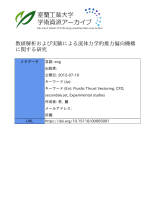Numerical and experimental studies of fluidic thrust vectoring mechanisms 数値解析および実験による流体力学的推力偏向機構に関する研究
Access this Article
Search this Article
Author
Bibliographic Information
- Title
-
Numerical and experimental studies of fluidic thrust vectoring mechanisms
- Other Title
-
数値解析および実験による流体力学的推力偏向機構に関する研究
- Author
-
李, 麗
- Author(Another name)
-
リ, リ
- University
-
室蘭工業大学
- Types of degree
-
博士 (工学)
- Grant ID
-
甲第325号
- Degree year
-
2012-03-23
Note and Description
博士論文
application/pdf
The Fluidic thrust vectoring (FTV) is emerging as a significant technology for high-performance air vehicles. The technology can improve aircraft maneuverability by manipulating the nozzle flow to deflect from its axial direction. The objectives of this study are to investigate the effect of a secondary jet on the primary flow in a converging-diverging nozzle, to discuss the effect of FTV parameters, and to evaluate the FTV performance. Numerical and experimental studies of FTV were carried out first with a preliminary nozzle, and then a series of investigations were carried out with an improved nozzle model. The experiments are performed with a nozzle pressure ratio (NPR) of 3–10, a secondary pressure ratio (SPR) of 1, 2 or 3, and two different secondary jet locations. Numerical simulations of the ozzle flow are done with solving the Navier-Stokes equations, and the input parameters are set to match the experimental conditions. Computations are performed with and without the secondary jet injection for different combinations of NPR, SPR, econdary jet location, and secondary angular injection. In the preliminary experiments, the slot for the secondary jet injection was so large that the flow deflection by an oblique shock is concealed by complex wave interactions. As a result, it was found difficult to evaluate the FTV performance quantitatively. The improved experimental model with a relatively small secondary jet slot was constructed to study the details of the FTV mechanism and its performance.The effects of FTV parameters, such as NPR, SPR, secondary jet location and inclination are discussed. The results show that the FTV arameters have direct effects on the FTV performance. The thrust pitching moment and the thrust pitching angle are determined to evaluate the FTV performance. A method using force-moment balance and a common procedure for utilizing the ratio of the radial to the axial momentums of exhaust gas is discussed in detail.The numerical results clearly indicate that the sign of the thrust pitching moment with the preliminary nozzle is opposite to that with the new nozzle. The pitching moment of the improved nozzle is positive as expected for oblique shock wave FTV. The relation between the thrust pitching moment and the thrust pitching angle shows the positive inter-relation etween them. Therefore, FTV performance can directly be evaluated with the thrust pitching moment.
